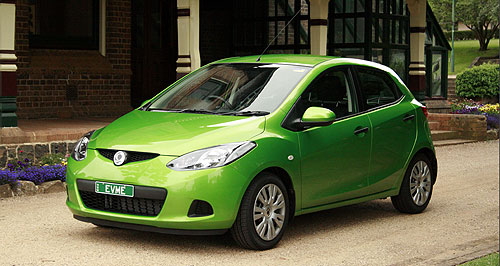Make / Model Search
News - General NewsAlliance to test EV grid integrationPower up: Energetique's EvMe is helping to pioneer electric motoring in Australia. Energetique teams up with Ergon to test integration of EVs with electricity grid31 Jul 2009 By TERRY MARTIN NICHE Australian electric vehicle (EV) outfit Energetique has announced a joint-venture project with Queensland’s Ergon Energy, and is in negotiation with a number of other power companies, to develop and test the integration of EVs with the electricity grid. As a working group within the Federal Chamber of Automotive Industries (FCAI) mulls the ramifications of mass-market plug-in hybrid and full-electric car launches from 2012, the fledgling independent Energetique – which has the Mazda2-based evMe EV on sale now – is forging alliances to assess a range of infrastructure issues, including the benefits and drawbacks of vehicle-to-grid (V2G) integration. Energetique chief executive Phil Coop told GoAuto it was crucial that electricity companies were prepared for an influx of vehicles drawing on their networks, and understood how to manage the integration “because they’re the ones that are going to bear the brunt of providing the ‘fuel’ for these cars”. He said that if integration was not well managed, EVs had the potential to exacerbate peak electricity demand, which could in turn force unforseen investments via network upgrades.  Left: Energetique CEO Dr Phillip Coop. Left: Energetique CEO Dr Phillip Coop.On the other hand, Dr Coop said EVs offered opportunities to mitigate peak demand, with car owners feeding electricity back to the grid from their vehicles – a bonus for the electricity utilities, as well as a means for motorists to reduce their running costs. For that to occur, however, the vehicles will need to be compatible with so-called “smart grid” digital technology that utilities are beginning to roll out across the world, including in Australia. “What they (the utilities) all want to do is to make sure that the electric vehicle industry comes up and has smart grid technology, which they can use in their grid filtering and their grid maintenance,” said Dr Coop. “It would be ridiculous to put a whole stack of cars on the charge at a peak energy load time, because that would finish them off – it’d be like putting 20,000 new air-conditioning systems on a network that was already suffering. “So the first issue is to mitigate the charging load.” Using smart grid technology, electricity companies can control the flow of energy between the vehicle and grid, enabling the flow to be slowed, delayed or even reversed. The network managers will be able to determine the optimal charging time, and the charge itself might come in bursts. “The really positive side is that that energy in the car is actually available to be put back on to the grid through V2G technology,” said Dr Coop. “In this way, the vehicle can deliver power when the utility requires it while still meeting the customers’ driving needs.” The Energetique chief said this sort of collaboration between the consumer and power retailer would allow households to reduce their energy costs and provide a valuable tool for the electricity provider to manage the network. It could also see electricity supply costs come down. “It sounds a bit blue sky, but the whole notion of community transport will change,” he said. “The car is going to be the next wave of technology to be integrated, just like the mobile phone and the palm pilot and the computer and the TV are all integrating – like converging technologies – the car has caught up with that now. And it has the added advantage of being able to provide energy for all this stuff as well. “It also consumes a substantial bunch (of energy) in itself. People who use fossil fuel – petrol – are sort of hidden from the sheer volume of energy they put into their tank each day. Once you get back to electricity, you suddenly realise that the electric car has a budget that is similar or more to what is used for the house. But the whole thing is going to be very transparent.” For ‘smart charging’ to occur at all, the vehicle must be equipped with software to interact with the smart grid when it is available. The evMe has it onboard, as does the recently launched plug-in version of Toyota’s Prius – dubbed Switch – developed by the University of Technology Sydney, which is conducting a V2G assessment program in collaboration with EnergyAustralia. GoAuto understands that most of the forthcoming EVs, including now the Chevrolet Volt, will also be compatible. However, Dr Coop said some car manufacturers were struggling with technology as they race to market with EVs. “We are in dialogue with a few of them, and we’re finding that they’re not coping that well,” he said. “It’s not entirely their fault – they are very large bureaucracies that manage to manufacture a car with a global logistics network so that you and I can buy one for $14,990 or something, which is a huge achievement. “But I think that they are still struggling with technology – they still need to prove the technology. Once they start going into production, they don’t want anything to start going wrong when they’ve got 100,000 vehicles in the marketplace. “There’s a lot of issues that haven’t been resolved yet, and a lot of standards that haven’t been set. And we’re right in the middle of all this.” Ergon Energy acting general manager of corporate development Glenn Walden said distributed energy would be one of the key responses to the challenges the company faces in delivering services to customers in the future. “Energy management systems and energy storage in particular will feature prominently in future supply solutions,” Mr Walden said. “It will also enable integration of greater levels of clean energy into the grid as renewable energy sources become more available.” Ergon Energy is owned by the Queensland government and services more than 650,000 residential and business customers across 97 per cent of the state – virtually all areas outside Brisbane. Energetique is based in Armidale, NSW, and builds the $70,000 evMe to order. It sold its first example in April, and has expressions of interest from more than 100 other customers. As GoAuto reported in June, Energetique has also signed a preliminary agreement with German automotive engineering service provider RLE International to develop and market the evMe platform in Europe. The Energetique-Ergon alliance follows an announcement from infrastructure provider Better Place last week that it will work with electricity retailer ActewAGL to establish an EV recharging network – which will include smart grid technology – in Canberra in 2012, ahead of a rollout in other states and territories.  Read more |
Click to shareGeneral News articlesResearch General News Motor industry news |












Facebook Twitter Instagram